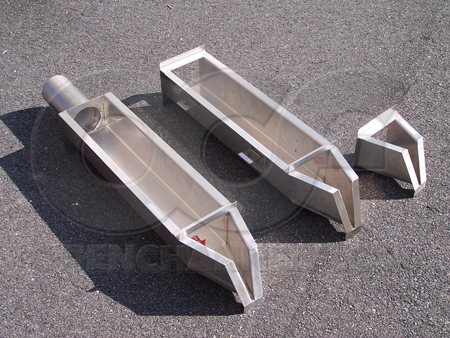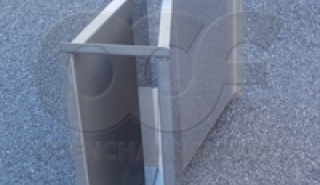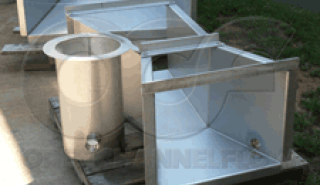In selecting a material of construction for a flume or a weir, it is not uncommon for the decision to be made “go with stainless” without a consideration of the grade of stainless that best fits the application.
Both T-304 and T-316 stainless steels are easy-to-fabricate and have similar mechanical strengths. From a flow measurement perspective the primary differences between the two grades is that T-316 provides superior resistance to oxidation and corrosion compared to T-304.
T-316 stainless offers higher heat resistance, while T-304 offers better elongation, but these properties generally are not considered important in open channel flow applications.
Based upon practical experience, Type 304 is satisfactory for chloride contents less than about 200 mg/l and are marginally satisfactory at levels from 200 and 1,000 mg/l. For hot water applications the chloride content is lowered dramatically (say from 200 to 50 mg/l) T-316 is preferred as it si for chloride content above 200 mg/l with an upper limit of about 1,000 mg/l.
Though a negligible corrosion rate is reported fro both 304 and 316 stainless steel in moist hydrogen sulfide, it is also reported that both may suffer corrosive attack when larges amounts of moist hydrogen sulfide occur. A suitable remedy is to provide appropriate ventilation. Surface attack and pitting can be minimized by water washing at regular intervals so that wet chlorine vapors cannot accumulate and condense.
Of the major grades of stainless steel T-304 accounts for about 53% of the market, while T-316 accounts for about 7%.

Applications for T-304 Stainless Steel Flumes and Weirs
With ease-of-fabrication, high strength, and good resistance to moderately acidic or caustic solutions, T-304 stainless steel works well in surface water applications.
These typically include:
- Stream gauging
- Irrigation flows
- Runoff studies
- Dam seepage monitoring
- Acidic mine discharge
Additionally, T-304 is a good choice when a level of abrasion resistance is required (e.g. mining applications) that cannot be met by other materials such as fiberglass.
T-304 stainless steel is suitable for potable and industrial waters with moderate chlorine content.
Flumes (other than Palmer-Bowlus), weir plates, and weir boxes are all suitable candidates for T-304 stainless steel construction. Weirs (both a portable plates and installed in boxes) are particularly good candidtates as the abrasion resistance characteristics of stainless steel help to keep weir crests sharp and the flow over them well developed.
Applications for T-316 Stainless Steel Flumes and Weirs
The addition of 2% molybdenum to chromium-nickel steels results in a steel that is heating-resistant and provides superior resistance to oxidation and corrosion resistance when exposed to many types of chemicals.
When it comes to open channel flow applications, though, temperature considerations are essentially meaningless. The flows through a flume or weir naturally have to be liquid so while T-316 stainless is more heat-resistant, this heat-resistance comes well above the boiling point of water.
T-316 is considerably more resistant to solutions of sulfuric acid, chlorides, bromides, iodides, and fatty acids at high temperature. In both industrial appications and those close to the sea, T-316 is commonly required.
In general, T-316 stainless steel is better for:
- Acetic acid
- Citric acid
- Hydrofluoric acid
- Hydrogen sulfide
- Phosphoric acid
- Sodium acetate
- Sulfuric acid
For portable and industrial waters with increase chlorine content, T-316 stainless steel is the right choice.
Note, though, T-316 stainless steel's superior resistance to corrosion and oxidation comes at a price: usally 40% more then T-304 construction.
Flumes and weir boxes are both candidates for T-316 stainless steel construction. As weir plates are normally installed in earthen channels and as such do are not exposed to the highly corrosive environments that require T-316 stainless steel, it is exceedingly rare for free-standing weir plates to be fabricated from it.
Stainless Steel in Wastewater
In selecting a grade of stainless the substances dissolved in the wastewater, primarily chlorides, should be considered first. Corrosion resistance to the surrounding atmosphere should also be considered – particularly the gaseous products which may develop during wastewater treatment.
For chlorine contents of 2 mg/l or less 304 and 316 do not corrode. From 3-5 mg/l 316 would be a more conservative choice. Where ozone is used as an oxidizing agent, 316 is preferred.
When comparing costs between stainless steel and other materials of construction, lifecycle costs are the key to a proper analysis. For example, while galvanized steel is cheaper to aquire, based upon an analysis of a wastewater equipment, galvanized steel can have a lifespan from 10-12 years, while T-304 stainless steel a lifespan of 18-20 years.
Sources: Performance of Stainless Steels in Waste Water Installations, Materials and Applications Series, Vol. 13, Euro Inox, Pumprite, Just Right Manufacturing





